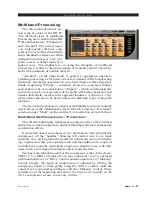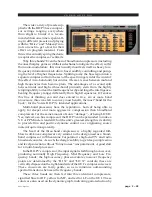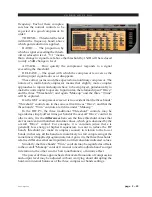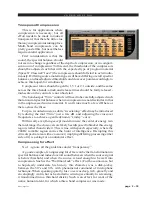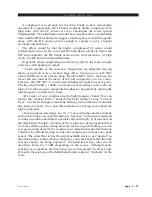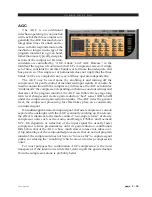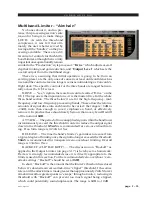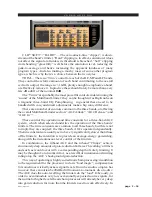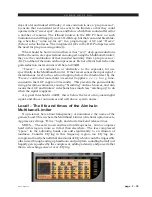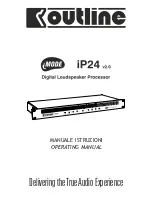
V O R S I S H D P 3 G U I
page 2 – 20
HD P3 / Aug 2006
Width
As alluded to under “M/S Microphones”, changing the difference path
gain in relation to the sum affects the apparent stereo “width”; reducing the
difference to zero leaves solely the sum, i.e. mono; if the path gains are
equal normal stereo occurs, but if the difference gain exceeds the sum, then
a “super-wide” image is possible. It is quite extraordinary to “hear” sonic
images come from outside the physical separation of a pair of speakers.
This technique is called “shuffling”, and like all good parlour-tricks is best
used in moderation - it is too easy to create “hole in the middle”, for the
stereo effect to disappear and with two mangled images huddling around
the speakers. Bear in mind that most good recording guys know this trick
already and use it to some degree, usually on reverbs; an inadvertent excess
added by your dainty hand can sound horrible.
Mono Low Frequencies
For disparate reasons, it has long been common for the heavy energy
containing low-frequency elements of a mix to be panned central on
recordings. Thankfully setting aside the constraints of disc-cutting(!), the
main reason is that it is possible to get up to 6dB more level when using
both channels mono-like instead of just one, as would be the case of
something panned hard left or right. (More level = loud = good, Igor!)
However, some program material isn’t like that, either because it’s old
(“stereofied” fifties and sixties singles, Beatles in particular) and having
instruments panned hard; the producers didn’t get the message; were
trying to be artsy; or it just naturally isn’t like that (jazz, classical). In the
kind of world the HD P3 inhabits, centering the LF energy has many
benefits: in FM the difference subcarrier is excited less, which translates
into less “scratchiness” on marginal signals; the LF can be made louder
(that two channels vs, one thing again); perceptual encoders can create
more efficient data compression with less difference energy to “aim”.
By high-pass filtering away the “difference” LF energy, one is just left
with that in the “sum” path, i.e. mono. Compression / limiting downstream
will allow any additional gain to be realized.
Naturally, this trick is not limited to just LF; particularly in conjunction
with “Width” (above), filtered, EQ’d and dynamically modified “differ-
ence” paths can lead to some interesting, some wild effects.
But a word of warning. If the station’s music library, shall we say,
owes much to the glory days of Napster, or otherwise contains aggres-
sively perceptually encoded material, one should be highly circumspect of
doing much in the way of “sum”/”difference” processing. Some percep-
tual encoders play games with, indeed take great liberties with, “differ-
ence” information during encoding, using the absolute bare minimum to
convince the ear of an image’s stereo positioning. By and large it works
very well in context, but not when the difference information is isolated or
exaggerated - like by the very techniques just described above. Then, there
can be excruciatingly nasty-sounding images at best, space-alien “beepity-
boop” noises at worst. (Go on, try it.)






















